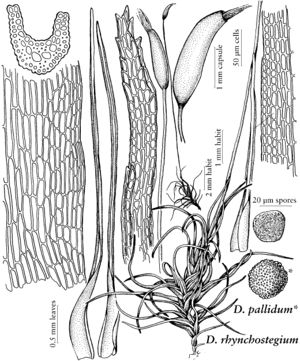Ditrichum pallidum
Flora 50: 182. 1867,.
Plants rather small, in silky green to yellowish green, loose to compact tufts. Stems short, to 0.5(–1) cm, usually simple. Leaves erect-spreading to subsecund, flexuose-contorted when dry, to 7 mm; from a short ovate-lanceolate and ± sheathing base gradually or rather shortly narrowed to an elongate subula, lamina 2-stratose distally; margins erect, becoming serrulate towards the apex, 1-stratose proximally, 2-stratose in the subula; costa rather thin and narrow at the base, broader distally and occupying most of the base of the subula, excurrent, in section with a broad band of guide cells and shallow adaxial and abaxial stereid bands; cells of the leaf base rectangular to oblong-hexagonal, narrowed towards the margin and forming a ± distinct hyaline zone, elongate-rectangular in distal leaf base and subula. Specialized asexual reproduction unknown. Sexual condition autoicous; perigonia axillary; perichaetial leaves shorter than stem leaves, the base not sheathing. Seta yellow or sometimes reddish brown near base, elongate, to 4 cm or occasionally longer, flexuose. Capsule suberect to somewhat inclined, yellow to brownish yellow, reddish brown with age, subcylindric, with a broadened base tapering gradually to a narrowed mouth, 1–2.5 mm, slightly asymmetric, weakly furrowed when dry and empty; operculum conic-rostrate, to about 0.8 mm; peristome 300–800 µm, pale brown to yellowish orange, 2-fid to a very short basal membrane, densely spiculose throughout. Calyptra long-cucullate. Spores rounded to obscurely tetrahedral, 15–30 µm, coarsely and sparsely papillose, brown.
Phenology: Capsules mature winter–summer (Feb–Jul).
Habitat: Sandy or clay soil, rather dry, open or partly shaded habitats
Elevation: low elevations
Distribution
N.B., N.S., Ont., Que., Ala., Ark., Conn., D.C., Fla., Ga., Ill., Ind., Iowa, Kans., Ky., La., Maine, Md., Mass., Mich., Miss., Mo., N.J., N.Y., N.C., Ohio, Okla., Pa., S.C., Tenn., Tex., Va., Vt., W.Va., Wis., Europe, e Asia (Japan), c Africa.
Discussion
When Ditrichum pallidum is fruiting, the long, yellow setae are distinctive. The slightly asymmetric capsule and the long, spiculose peristome teeth are similar to those of D. difficile (Duby) Fleischer, a widespread, common species occurring in Mexico, Central and South America as well as elsewhere throughout the world, and D. rhynchostegium. However, the spores of all three species are easily distinguished. Spores of D. difficile are finely papillose-verrucose and 12–18(–20) µm; those of D. rhynchostegium are vermicularly papillose-verrucose and 11–15(–18) µm; those of D. pallidum are larger, 15–30 µm, and the exine ornamentation coarsely and openly papillose.
Herbarium specimens of Ditrichum pallidum and D. rhynchostegium are sometimes misidentified. If fruiting, the orange to reddish seta of D. rhynchostegium will immediately distinguish it from D. pallidum with its yellowish seta. Also, spores of D. rhynchostegium have a distinctly vermicular ornamentation and are smaller. The operculum of D. pallidum is about half the length of that of D. rhynchostegium. Vegetatively, plants of D. pallidum have short stems and the leaf base is often ovate to ovate-lanceolate, being gradually narrowed to the subula. On the other hand, plants of D. rhynchostegium have longer stems and the leaf base is oblong-ovate and abruptly narrowed to the subula. L. E. Anderson and V. S. Bryan (1958) discussed the similarity of D. currituckii and D. pallidum, but maintained them as distinct species. H. A. Crum and Anderson (1980–1983) considered D. currituckii to be a variant form of D. pallidum having shorter capsules and peristomes, slightly shorter leaves with the costa somewhat broader at the base. The morphological and cytological differences were considered by Crum and Anderson (1981) to be insufficient to warrant separation.
Selected References
None.
